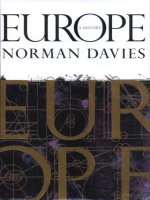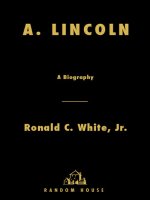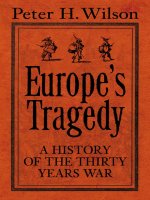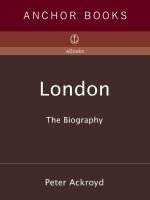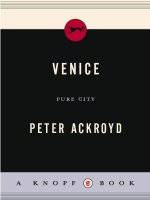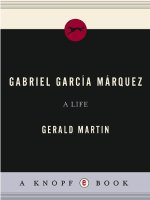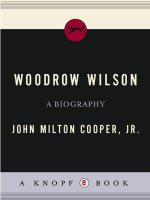Peter ackroyd london a biography (v5 0)
Bạn đang xem bản rút gọn của tài liệu. Xem và tải ngay bản đầy đủ của tài liệu tại đây (8.49 MB, 654 trang )
Acclaim for Peter Ackroyd’s
London: The Biography
“The book requires a leisurely pace; anything quicker would endanger the pleasure to be had from
the variety on offer…. There is nothing quite like it.”
—The Boston Globe
“Ackroyd gives London a gift, the likes of which more callow cities can only hope, one day, to get.”
—San Francisco Chronicle
“Invariably exciting and immensely enjoyable…. Ackroyd coruscates with ideas and fancies…. The
total e ect is spectacular and vastly stimulating. ‘When a man is tired of London, he is tired of life.’
The same could be said with equal justice of any reader who nds no pleasure or instruction in
Ackroyd’s books.”
—The Spectator
“Ackroyd writes in a wonderfully graphic style that carries the reader through historical byways
effortlessly.”
—The Denver Post
“A tour de force by a writer of immense skill…. A treasure of information and anecdote about one
of the world’s great cities, a book to be taken up again and again for the pleasures that lie within.”
—The Seattle Times
“Ackroyd deserves great praise for writing a book equal to its gargantuan subject…. [It] succeeds on
the most expansive and most intimate levels.”
— The Orlando Sentinel
“Packed with strange delights and bizarre occurrences…. Ackroyd is a writer of memorable,
eccentrically rhythmic sentences that one wants to quote at length.”
—Newsday
“Enthralling…. Witty and imaginative.”
—Publishers Weekly (starred)
“Wonderful and weighty…. Ackroyd has created a rich celebration of a unique city.”
—The Wall Street Journal
By the same author
FICTION
The Great Fire of London
The Last Testament of Oscar Wilde
Hawksmoor
Chatterton
First Light
English Music
The House of Doctor Dee
Dan Leno and the Limehouse Golem
Milton in America
The Plato Papers
BIOGRAPHY
T. S. Eliot
Dickens
Blake
The Life of Thomas More
POETRY
The Diversions of Purley
CRITICISM
Notes for a New Culture
Peter Ackroyd
London
Peter Ackroyd is a bestselling writer of both ction and non ction. His most recent books include the biographies
Dickens, Blake, and Thomas More and the novels The Trial of Elizabeth Cree, Milton in America, and The Plato
Papers. He has won the Whitbread Biography Award, the Royal Society of Literature’s William Heinemann Award
(jointly), the James Tait Black Memorial Prize, and The Guardian fiction prize. He lives in London.
For Jain Johnston
and
Frederick Nicholas Robertson
Contents
List of Illustrations
Chronology
Acknowledgements
The City as Body
From Prehistory to 1066
1 The Sea!
2 The Stones
3 Holy! Holy! Holy!
The Early Middle Ages
4 You Be All Law Worthy
London Contrasts
5 Loud and Everlasting
6 Silence Is Golden
The Late Medieval City
7 This Companye
Onward and Upward
8 Rather Dark and Narrow
9 Packed to Blackness
10 Maps and Antiquarians
Trading Streets and Trading Parishes
11 Where Is the Cheese of Thames Street?
A London Neighbourhood
12 The Crossroads
London as Theatre
13 Show! Show! Show! Show! Show!
14 He Shuld Neuer Trobell the Parish No More
15 Theatrical City
16 Violent Delights
17 Music, Please
18 Signs of the Times
19 All of Them Citizens
Pestilence and Flame
20 A Plague Upon You
21 Painting the Town Red
After the Fire
22 A London Address
23 To Build Anew
Crime and Punishment
24 A Newgate Ballad
25 A Note on Suicide
26 A Penitential History
27 A Rogues Gallery
28 Horrible Murder
29 London’s Opera
30 Raw Lobsters and Others
31 Thereby Hangs a Tale
Voracious London
32 Into the Vortex
33 A Cookery Lesson
34 Eat In or Take Away
35 Market Time
36 Waste Matter
37 A Little Drink or Two
38 Clubbing
39 A Note on Tobacco
40 A Bad Odour
41 You Sexy Thing
42 A Turn of the Dice
London as Crowd
43 Mobocracy
44 What’s New?
The Natural History of London
45 Give the Lydy a Flower
46 Weather Reports
47 A Foggy Day
Night and Day
48 Let There Be Light
49 Night in the City
50 A City Morning
London’s Radicals
51 Where Is the Well of Clerkenwell?
Violent London
52 A Ring! A Ring!
Black Magic, White Magic
53 I Met a Man Who Wasn’t There
54 Knowledge Is Power
A Fever of Building
55 London Will Soon Be Next Door to Us
56 Nothing Quite Like It
London’s Rivers
57 You Cannot Take the Thames with You
58 Dark Thames
59 They Are Lost
Under the Ground
60 What Lies Beneath
Victorian Megalopolis
61 How Many Miles to Babylon?
62 Wild Things
63 If It Wasn’t for the ‘ouses in Between
London’s Outcasts
64 They Are Always with Us
65 Can You Spare a Little Something?
66 They Outvoted Me
Women and Children
67 The Feminine Principle
68 Boys and Girls Come Out to Play
Continuities
69 Have You Got the Time?
70 The Tree on the Corner
East and South
71 The Stinking Pile
72 The South Work
The Centre of Empire
73 Maybe It’s Because I’m a Londoner
74 Empire Day
After the Great War
75 Suburban Dreams
Blitz
76 War News
Refashioning the City
77 Fortune not Design
Cockney Visionaries
78 Unreal City
79 Resurgam
An Essay on Sources
List of Illustrations
BLACK-AND-WHITE INSERT I
Early Londoner admiring London Stone (Guildhall Library, Corporation of
London)
John Stow (Guildhall Library, Corporation of London)
Charter of William I (Corporation of London Records Office)
Marcellus Laroon, Street merchants
Aerial sketch of London, 1560 (Guildhall Library, Corporation of London)
View of London Bridge by Anthonis van den Wyngaerde (Ashmolean Museum,
Oxford)
Panorama of London by Hollar (Guildhall Library, Corporation of London)
View of Old St. Paul’s by Hollar (Guildhall Library/Corporation of London,
UK/Bridgeman Art Library)
The Royal Exchange by Hollar (Courtesy of the Museum of London)
Detail of map charting the Great Fire of London, 1666 (Royal Academy of Arts
Library, London, UK/Bridgeman Art Library)
17th c. remen (Royal Academy of Arts Library, London, UK/Bridgeman Art
Library)
Hanging outside of Newgate Prison by Rowlandson (Courtesy of the Museum
of London)
Moll Cut-Purse (Courtesy of the Museum of London)
Newgate Prison (Courtesy of the Museum of London)
National Temperance map of London (Courtesy of the Museum of London)
Café Monico, Piccadilly Circus (Courtesy of the Museum of London)
COLOR INSERT I
London from Southwark, Dutch School, c.1630 (Courtesy of the Museum of
London)
Entrance to the River Fleet, Samuel Scott (Guildhall Art Gallery, Corporation of
London)
Detail of the City from Braun and Hogenberg’s map of London, 1572
(Guildhall Library, Corporation of London, UK/Bridgeman Art Library)
Johann B. Homann’s map and prospect of London, 1730 (British Library,
London, UK/Bridgeman Art Library)
The Great Fire of London, 1666 aquatint after Philippe de Loutherbourg
(Guildhall Library, Corporation of London, UK/Bridgeman Art Library)
The Burning of the Houses of Parliament, 16th October 1834, J.M.W. Turner
(Philadelphia Museum of Art, Philadelphia, PA, USA/Bridgeman Art
Library)
Jack Sheppard, William Thornhill (Courtesy of the Museum of London)
Tom, Jerry and Logic Visiting Condemned Prisoners of Newgate Prison, George and
Isaac Cruikshank (Guildhall Library, Corporation of London, UK/Bridgeman
Art Library)
The Curds and Whey Seller, Cheapside, c. 1730, British School (Courtesy of the
Museum of London)
The Meat Stall from The London Markets, engraved by M. Dubourg after James
Pollard (Guildhall Library, Corporation of London, UK/Bridgeman Art
Library)
Smith eld Market, engraved by R.G. Reeve after James Pollard (British
Museum, London, UK/Bridgeman Art Library)
The Frozen Thames, c.1677, Abraham Hondius (Courtesy of the Museum of
London)
Punch or May Day, Benjamin Haydon (Tate Gallery, London/Art Resource, NY)
A Rake’s Progress IV: The Arrested, Going to Court, William Hogarth (Courtesy of
the Trustees of Sir John Soane’s Museum, London/Bridgeman Art Library)
The Four Times of Day: Morning, William Hogarth (Upton House, Oxfordshire,
UK/Bridgeman Art Library)
Whitehall and the Privy Gardens from Richmond House, Canaletto (By courtesy of
the Trustees of the Goodwood Collection)
View of the Adelphi from the River Thames, William Marlow (Christie’s Images,
London, UK/Bridgeman Art Library)
COLOR INSERT II
The Laying of the Water Main in Tottenham Court Road, George Scharf (British
Museum, London, UK/Bridgeman Art Library)
The Scavenger’s Lamentation, engraved by A. Sharpshooter (Guildhall Library,
Corporation of London)
The Enraged Musician, William Hogarth (Ashmolean Museum, Oxford,
UK/Bridgeman Art Library)
The Railway Station, William Frith (Royal Holloway and Bedford New College,
Surrey, UK/Bridgeman Art Gallery)
The Crowd, Robert Buss (Guildhall Art Gallery, Corporation of London)
Piccadilly Circus, Charles Ginner (Tate Gallery, London/Art Resource, NY)
Hammersmith Bridge on Boat Race Day, Walter Greaves (Tate Gallery,
London/Art Resource, NY)
Noctes Ambrosianae, Walter Sickert (Castle Museum and Art Gallery,
Nottingham, UK/Bridgeman Art Library/© 2001 Artists Rights Society
[ARS], New York, NY/DACS, London)
Hammersmith Palais de Danse, Malcolm Drummond (Plymouth City Museum
and Art Gallery)
A Coffee Stall, Chas Hunt (Courtesy of the Museum of London)
The Co ee House, William Ratcli e (Southampton City Art Gallery,
Hampshire, UK/Bridgeman Art Library)
Allen’s Tobacconist Shop, Hart Street, Grosvenor Square, Robert Allen (Courtesy
of the Museum of London)
House, Rachel Whiteread (Anthony d’Offay Gallery)
Two Sleepers, Henry Moore (The Henry Moore Foundation/Walter Hussey
Bequest, Pallant House, Chichester, UK/Bridgeman Art Library)
Devastation, 1941: An East End Street, Graham Sutherland (Tate Gallery,
London/Art Resource, NY)
Canary Wharf, Isle of Dogs, 1991, Alan Delaney (Courtesy of the Museum of
London)
BLACK-AND-WHITE INSERT II
Regent Street in 1886, London Stereoscopic Company (Courtesy of the Museum
of London)
Covent Garden Porters, John Thomson (Courtesy of the Museum of London)
Old houses in Bermondsey
Clerkenwell Green
River scavengers
Women sifting through dust mounds
The Great Wheel, Earl’s Court Exhibition, 1890, Charles Wilson (Courtesy of the
Museum of London)
Children Following a Water Cart, William Whi n (Tower Hamlets Local History
Library)
Boy selling matches
Children Playing Cricket
(Hulton/Archive)
in
Alpha
Road,
Millwall,
1938,
Fox
Photos
A Thoroughbred November and London Particular, engraved by George Hunt
after M. Egerton (Guildhall Library/Corporation of London)
Car in smog, Henry Grant (Courtesy of the Museum of London)
A Paraleytic Woman, Géricault (Bibliothèque Nationale de France, Paris)
Protein Man (Davidson/Evening Standard/Hulton/Archive)
Bomb damage in Paternoster Row, 1940 (Cecil Beaton photograph, courtesy
of Sotheby’s London)
Near Spitalfields Market (© Don McCullin/Contact Press)
PART OPENERS
Plan of remains of Roman ship (Courtesy of the Museum of London)
Matthew Paris map of London, 1252 (By permission of the British Library
[ROY.14.C.VII f2])
Dore, Ludgate Hill
Tudor depiction of the market at Eastcheap (By permission of the Folger
Shakespeare Library)
Mid-16th c. map of Moorfields (Courtesy of the Museum of London)
Marcellus Laroon, The Merry Milkmaid
The Rookery of St. Giles (Courtesy of the Museum of London)
Punch and Judy puppet show (Courtesy of the Museum of London)
Great Plague of 1665 (Pepys Library, Magdalene College, Cambridge)
Christopher Wren and John Evelyn plan of London after the Great Fire, 1666
(Courtesy of the Museum of London)
Rowlandson depiction of hanging (Courtesy of the Museum of London)
Rowlandson, Revellers at Vauxhall (Courtesy of the Museum of London)
Gillray caricature of Sheridan as Punch (Guildhall Library, Corporation of
London)
Cockney flower seller in Covent Garden (Courtesy of the Museum of London)
Dore, vagrants huddled on Westminster Bridge
The Sessions House on Clerkenwell Green (Guildhall Library, Corporation of
London)
The burning of Newgate Prison, 1780, Gordon Riots (Guildhall Library,
Corporation of London)
Title page of Astrologaster of the Figure Caster by John Melton
Scharf, the building of Carlton House Terrace, c. 1830
Girgnion engraving of the Fleet River (Guildhall Library, Corporation of
London)
Mayhew, The Sewer Hunter (Courtesy of the Museum of London)
Dore, Seven Dials Slum
Géricault, Pity the Sorrow of a Poor Old Man (Bibliothèque Nationale de France,
Paris)
The Mud-lark (Courtesy of the Museum of London)
Scharf, The Original Oyster Shop
Whistler, Billingsgate (Courtesy of the Museum of London)
Hogarth, A Harlot’s Progress
London Underground poster, 1929
St. Paul’s Cathedral (Imperial War Museum, London)
Poster for the Lansbury Council Estate in Poplar (Courtesy of the Museum of
London)
Tribute to Christopher Wren (Guildhall Library, Corporation of London)
Chronology
BC
54 Caesar’s first expedition to Britain
AD
41 The Roman invasion of Britain
43 The naming of Londinium
60 The burning of London by Boudicca
61–122 The rebuilding of London
120 The Hadrianic fire of London c.
c. 190 The building of the great wall
407 The Roman withdrawal from London
457 Britons flee London to evade the Saxons
490 Saxon domination over London
587 Augustine’s mission to London
604 Foundation of a bishopric, and St. Paul’s, in London
672 Reference to “the port of London.” The growth of Lundenwic
851 London stormed by Vikings
886 Alfred retakes and rebuilds London
892 Londoners repel Danish invasion fleet
959 A great fire in London: St. Paul’s burned
994 Siege of London by Danish forces
1013 The second siege of London, by conquering Sweyn
1016 Third siege of London by Cnut, repulsed
1035 Harold I elected king by Londoners
1050 The rebuilding of Westminster Abbey
1065 Dedication of Westminster Abbey
1066 The taking of London by William the Conqueror
1078 The building of the White Tower
1123 Rahere establishes St. Bartholomew’s
1176 The building of a stone bridge
1191 The establishment of a London commune
1193–1212 The first mayor of London, Henry Fitz-Ailwin
1220 Rebuilding of Westminster Abbey
1290 Expulsion of the Jews; Eleanor Crosses set up at Chepe and Charing
Cross
1326 The London revolution: deposition of Edward II
1348 The Black Death kills one-third of London’s population
1371 Charterhouse founded
1373 Chaucer living above Aldgate
1381 Wat Tyler’s revolt
1397 Richard Whittington first elected mayor
1406 Plague in London
1414 The Lollard revolt
1442 The Strand is paved
1450 Jack Cade’s revolt
1476 The establishment of Caxton’s printing press
1484 The sweating sickness in London
1485 Henry VII enters London in triumph after the Battle of Bosworth
1509 Henry VIII ascends the throne
1535 Execution of Thomas More on Tower Hill
1535–9 The spoilation of London’s monasteries and churches
1544 Wyngaerde’s great panorama of London
1576 The building of the Theatre in Shoreditch
1598 Publication of Stow’s Survey of London
1608–13 The construction of the New River
1619–22 The building of Inigo Jones’s Banqueting House
1642–3 The construction of earthen walls, and forts, against the king’s army
1649 Execution of Charles I
1652 The emergence of the coffee house
1663 The building of a theatre in Drury Lane
1665 The Great Plague
1666 The Great Fire
1694 The foundation of the Bank of England
1733 The covering of the Fleet River
1750 The building of Westminster Bridge
1756 The construction of the New Road
1769 The building of Blackfriars Bridge
1769–70 Wilkite agitation in London
1774 The London Building Act
1780 The Gordon Riots
1799 The establishment of the West India Dock Company
1800 The foundation of the Royal College of Surgeons
1801 London’s population reaches one million
1809 Gas-lighting instituted in Pall Mall
1816 Radicals meet at Spa Fields: riots in Spitalfields
1824 National Gallery founded
1825 Nash rebuilds Buckingham Palace
1829 London Metropolitan Police Force founded
1834 Houses of Parliament destroyed by fire
1836 University of London established
1851 The Great Exhibition opened in Hyde Park
1858 The “great stink” leads to Bazalgette’s sanitary engineering
1863 The opening of the world’s first underground railway
1878 The advent of electric lighting
1882 The emergence of the electric tram-car
1887 “Bloody Sunday” demonstrations in Trafalgar Square
1888 The appearance of Jack the Ripper in Whitechapel
1889 The establishment of the London County Council
1892 The beginning of the Blackwall Tunnel under the Thames
1897 The emergence of the motor-omnibus
1901 Population of London reaches 6.6 million
1905 Epidemic of typhus. Aldwych and Kingsway opened to traffic
1906 Suffragettes demonstrate in Parliament Square
1909 The opening of Selfridge’s department store
1911 The siege of Sidney Street
1913 The inauguration of the Chelsea Flower Show
1915 The first bombs fall on London
1926 The General Strike
1932 The building of Broadcasting House in Portland Place for the BBC
1935 The inauguration of the Green Belt
1936 The battle of Cable Street
1940 The beginning of the London Blitz
1951 The Festival of Britain on the South Bank
1952 The great smog
1955 The opening of Heathrow Airport
1965 The abolition of the London County Council; creation of the Greater
London Council
1967 The closure of the East India Dock; the building of Centre Point
1981 The Brixton riots; the establishment of the London Docklands
Development Corporation
1985 Broadwater Farm riots
1986 Completion of M25 ringway; abolition of GLC; the “big bang” in the
Stock Exchange
1987 The building of Canary Wharf
2000 Mayoral elections
Acknowledgements
The author and publisher are grateful to the following for permission to reproduce illustrative material which
appears in the text pages: Bibliothèque Nationale, Paris, 587; British Library, 43; Folger Shakespeare Library,
Washington, D.C., 81; Guildhall, 383, 455, 471, 529, 751; Imperial War Museum, 721; Magdalene College,
Cambridge, 191; Museum of London, 5, 89, 121, 135, 219, 237, 297, 403, 551, 613, 661, 735.
The author and publisher are grateful to the following for permission to reproduce copyright material: Italo
Calvino, Invisible Cities (Secker & Warburg and the Wylie Agency (UK) Ltd.); Sally Holloway, Courage High
(HMSO); Mike and Trevor Phillips, Windrush: the Irresistible Rise of Multi-Racial Britain (HarperCollins); Virginia
Woolf, The Diaries, ed. Anne Oliver Bell (the Executors of the Estate of Virginia Woolf, The Hogarth Press and
Harcourt Brace).
The jacket and endpapers show details from the following paintings and photographs:
Front cover: London from Southwark, c.1630, British School; The Great Wheel, Earl’s Court Exhibition, 1890, by
Charles Wilson; Curds and Whey Seller, Cheapside, c.1730, British School; Coombe and Co’s Brewer’s, St. Giles,
c.1875, by Alfred and John Bool © Museum of London; Canary Wharf from the Isle of Dogs; Thames Barrier ©
Matthew Weinreb; inside ap: The Crawlers, c.1876, by John Thomson © Museum of London; Lloyds of London
© Matthew Weinreb; back cover: May Morning, c.1760, by John Collet; Allen’s Tobacconist Shop, c.1841, by
Robert Allen; A Shop in Maccles eld Street, Soho, 1883, by Henry Dixon; Su ragette Demonstration in Trafalgar
Square, c.1908, © Museum of London; Simpson’s of Piccadilly; John Lewis, Oxford Street © Matthew Weinreb;
inside ap: Westminster Bridge from the River Looking South, c.1750, British School; Railway Maintenance Gang,
St. Pancras, c.1900, by Rev. John Galt © Museum of London; spine: Regent Street, c.1886, anon. © Museum of
London; endpapers: Seven Phases in the Evolution of Old London Bridge © Museum of London.
Cartography on pages xxvi–xxix by Pamela Talese.
While the publishers have made every e ort to trace the owners of copyright, they will be happy to rectify any
errors or omissions in further editions.
The City as Body
T
he image of London as a human body is striking and singular; we may trace it from the pictorial emblems of
the City of God, the mystical body in which Jesus Christ represents its head and the citizens its other
members. London has also been envisaged in the form of a young man with his arms outstretched in a gesture of
liberation; the figure is taken from a Roman bronze but it embodies the energy and exultation of a city continually
expanding in great waves of progress and of con dence. Here might be found the “heart of London beating
warm.”
The byways of the city resemble thin veins and its parks are like lungs. In the mist and rain of an urban
autumn, the shining stones and cobbles of the older thoroughfares look as if they are bleeding. When William
Harvey, practising as a surgeon in St. Bartholomew’s Hospital, walked through the streets he noticed that the
hoses of the re engines spouted water like blood from a cut artery. Metaphorical images of the Cockney body
have circulated for many hundreds of years: “gob” was rst recorded in 1550, “paws” in 1590, “mug” in 1708 and
“kisser” in the mid-eighteenth century.
Harvey’s seventeenth-century hospital was beside the shambles of Smithfield, and that conjunction may suggest
another image of the city. It is fleshy and voracious, grown fat upon its appetite for people and for food, for goods
and for drink; it consumes and it excretes, maintained within a continual state of greed and desire.
For Daniel Defoe, London was a great body which “circulates all, exports all, and at last pays for all.” That is
why it has commonly been portrayed in monstrous form, a swollen and dropsical giant which kills more than it
breeds. Its head is too large, out of proportion to the other members; its face and hands have also grown
monstrous, irregular and “out of all Shape.” It is a “spleen” or a great “wen.” A body racked with fever, and
choked by ashes, it proceeds from plague to fire.
Whether we consider London as a young man refreshed and risen from sleep, therefore, or whether we lament
its condition as a deformed giant, we must regard it as a human shape with its own laws of life and growth.
Here, then, is its biography.
Some will object that such a biography can form no part of a true history. I admit the fault and plead in my
defence that I have subdued the style of my enquiry to the nature of the subject. London is a labyrinth, half of
stone and half of esh. It cannot be conceived in its entirety but can be experienced only as a wilderness of alleys
and passages, courts and thoroughfares, in which even the most experienced citizen may lose the way; it is
curious, too, that this labyrinth is in a continual state of change and expansion.
The biography of London also de es chronology. Contemporary theorists have suggested that linear time is
itself a gment of the human imagination, but London has already anticipated their conclusions. There are many
di erent forms of time in the city, and it would be foolish of me to change its character for the sake of creating a
conventional narrative. That is why this book moves quixotically through time, itself forming a labyrinth. If the
history of London poverty is beside a history of London madness, then the connections may provide more
significant information than any orthodox historiographical survey.
Chapters of history resemble John Bunyan’s little wicket-gates, while all around lie sloughs of despond and
valleys of humiliation. So I will sometimes stray from the narrow path in search of those heights and depths of
urban experience that know no history and are rarely susceptible to rational analysis. I understand a little, and I
trust that it will prove enough. I am not a Virgil prepared to guide aspiring Dantes around a de ned and circular
kingdom. I am only one stumbling Londoner who wishes to lead others in the directions which I have pursued
over a lifetime.
The readers of this book must wander and wonder. They may become lost upon the way; they may experience
moments of uncertainty, and on occasions strange fantasies or theories may bewilder them. On certain streets
various eccentric or vulnerable people will pause beside them, pleading for attention. There will be anomalies and
contradictions—London is so large and so wild that it contains no less than everything—just as there will be
irresolutions and ambiguities. But there will also be moments of revelation, when the city will be seen to harbour
the secrets of the human world. Then it is wise to bow down before the immensity. So we set o in anticipation,
with the milestone pointing ahead of us “To London.”
Peter Ackroyd
London
March 2000
From Prehistory to 1066
The relics of past ages have been found beneath many areas of London; they are the
foundations upon which it rests.
